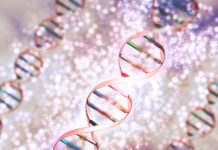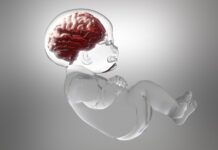Even though all of us share 99.9 percent of our DNA, the remaining 0.1 percent is enough to make each of us unique.
In all our myriad variations, everything we are is determined, at least partially, by what is written in our genes. While you may wish for your baby to have your eyes, his father’s freckles, and his grandfather’s talent for baseball, we all know that it isn’t as simple as that.
The first of a baby’s cells are created when a sperm fuses with an egg, and this is the cell from which all others will be created. Within the nucleus of each cell are 46 chromosomes in 23 matching pairs, with one chromosome per pair inherited from each parent.
These chromosomes are basically a recipe book or instruction manual for how to make certain proteins, which will form the building blocks of our bodies and functions. When examined closely, each chromosome is like a long thin string of beads (with each bead representing a gene) twisted into the shape of a double helix.
A gene is made up of deoxyribonucleic acid, more commonly known as DNA, and each gene contains an important bit of information about our health and development. These chromosome structures are so vast and complex that if the DNA contained within just one human cell was unfurled to its full length, it would measure 6 ft (1.8 m); the height of a tall human being.
One of the most important pieces of information contained within a cell is the instruction that determines gender, and whether your baby is going to be a boy or a girl is “decided” by the father.
Each egg or ovum (female reproductive cell) contains within it an X sex chromosome, while each sperm (male reproductive cell) can contain either an X or a Y chromosome, in roughly equal measure.
So, it is simply a question of which of these sperm meets the egg first that will determine whether your baby is XX (a girl) or XY (a boy). Theoretically these outcomes each have a 50 percent chance, just like a coin toss, and indeed the world sex ratio does remain roughly even, but a few more boys are born each year than girls (about 51 percent at this point in time).
Your parents would have to have another 1,000,000,000,000,000 babies to stand a chance of having another you.
Some scientists theorize that this is due to the fact that Y-chromosome sperm are a little smaller and therefore may simply be able to get to the egg faster, but the lifestyle of the baby’s parents may also have an effect.
One study revealed that women who eat cereal for breakfast every morning are more likely to conceive a boy than noncereal eaters (59 percent, as opposed to 43 percent), but whether this is related to the cereal or some other common factor is unclear.

We all know a family who has a lot of daughters and no sons, or vice versa, but it is interesting to note that, in fact, at the moment of conception they have the same 50–50 chance as everyone else.
Your baby’s genes will decide his other physical characteristics too, such as blood type, eye color, height, and whether he will or won’t develop certain health conditions. They also influence behavioral characteristics, such as his talents and intelligence, but which gene he will inherit and which trait he will express will depend on a number of factors.
Every person inherits two versions of each gene, and in some cases one of the pair will be dominant and one recessive. So, in the case of blood type, A is dominant over O. If you are AA (if both your parents had type A blood) and your partner is AO, your baby will definitely have type A blood because even if she took an A from your side and an O from your partner (to become AO), the A would be expressed as it is dominant.
The only way to end up with O blood is to inherit an O from each parent, therefore becoming OO. Other examples of dominant traits include dark hair (which is dominant over other hair colors), brown eyes (which dominate other eye colors), and dimples dominate over no dimples.




















